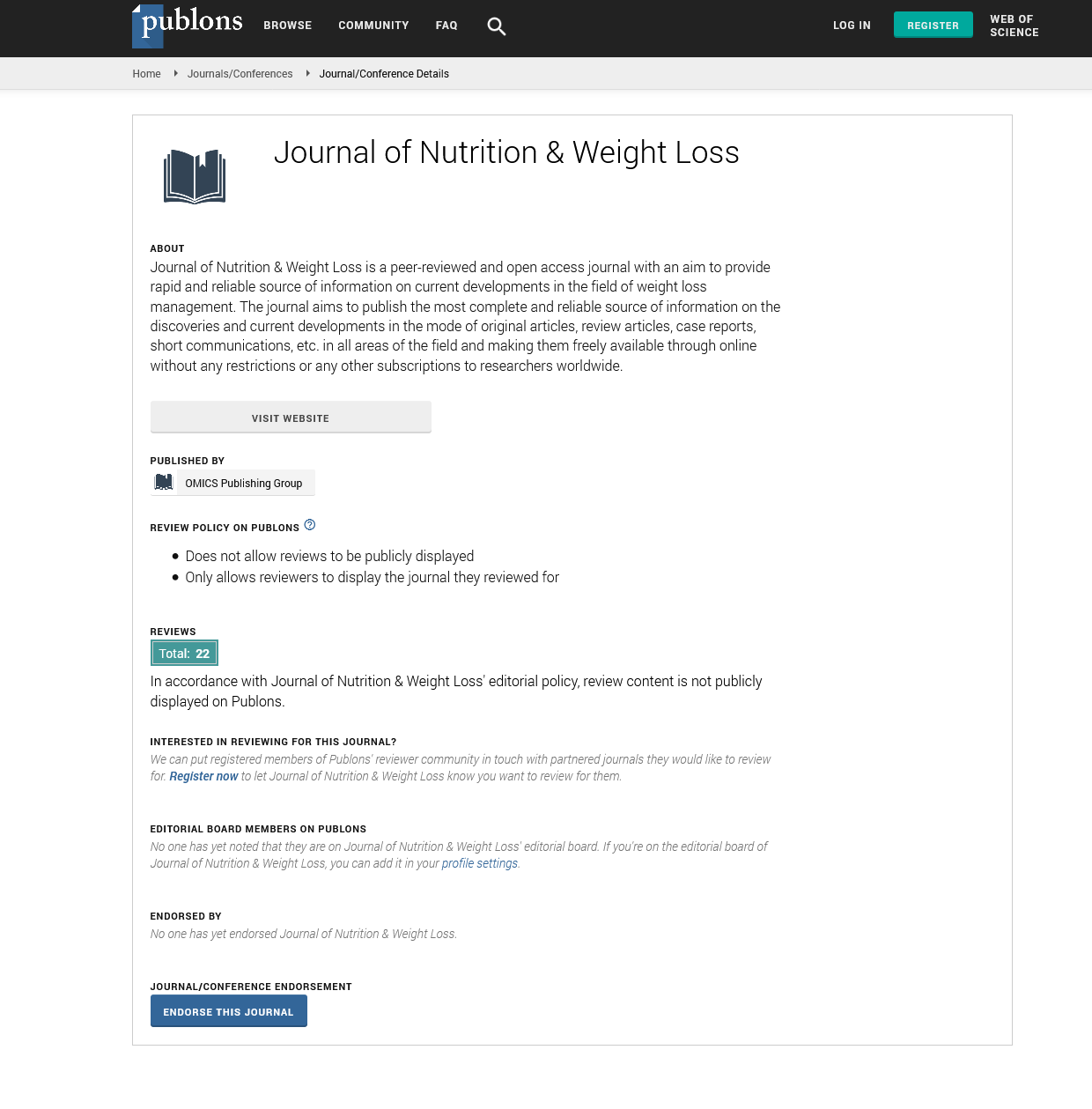Indexed In
- RefSeek
- Hamdard University
- EBSCO A-Z
- Publons
- Euro Pub
- Google Scholar
Useful Links
Share This Page
Journal Flyer

Open Access Journals
- Agri and Aquaculture
- Biochemistry
- Bioinformatics & Systems Biology
- Business & Management
- Chemistry
- Clinical Sciences
- Engineering
- Food & Nutrition
- General Science
- Genetics & Molecular Biology
- Immunology & Microbiology
- Medical Sciences
- Neuroscience & Psychology
- Nursing & Health Care
- Pharmaceutical Sciences
Commentary - (2023) Volume 8, Issue 2
The Metabolic Pathway: Unraveling the Connection between Metabolism and Weight Loss
Ramesh Varma*Received: 15-May-2023, Manuscript No. JNWL-23-22281; Editor assigned: 17-May-2023, Pre QC No. JNWL-23-22281 (PQ); Reviewed: 31-May-2023, QC No. JNWL-23-22281; Revised: 07-Jun-2023, Manuscript No. JNWL-23-22281 (R); Published: 14-Jun-2023, DOI: 10.35248/2593-9793.23.8.170
Description
Metabolism is a fundamental and intricate biological process that plays a vital role in weight loss and overall health. It involves the conversion of food and beverages into energy that fuels various bodily functions, from basic movements to cellular repair. The speed at which this conversion occurs is known as metabolic rate, and it can have significant implications for weight management. Understanding metabolism is vital as it sheds light on why some individuals seem to lose weight more easily than others. A higher metabolic rate means the body is burning energy at a faster pace, potentially facilitating weight loss. Conversely, a slower metabolism might make it more challenging to shed pounds. In this article, we will delve into the complexities of metabolism, examining its impact on weight loss and health. Additionally, we will explore the various factors that influence metabolic rate, such as age, genetics, physical activity, and dietary habits. By gaining a better understanding of metabolism, readers can make informed decisions about their weight management strategies and overall well-being.
Understanding metabolism
Metabolism is a two-part process consisting of anabolism and catabolism. Anabolism involves the creation of compounds that the body needs, while catabolism breaks down molecules to generate energy. This energy is then used to fuel various bodily functions, from breathing to thinking. The rate at which these processes occur is known as the metabolic rate, which varies among individuals. Factors such as age, gender, genetics, and body composition can influence one’s metabolic rate.
The metabolic rate and weight loss
A higher metabolic rate implies that the body is using energy more quickly, even at rest. This is why individuals with a higher metabolism tend to burn more calories and, consequently, have an easier time losing weight or maintaining a healthy weight. However, it’s essential to mention that a higher metabolism isn’t a weight loss magic bullet. It’s just one piece of the weight management puzzle, along with diet, exercise, and other lifestyle factors.
Factors influencing metabolism
Several factors can influence metabolism, including age, gender, genetics, and body composition. For instance, muscle tissue is more metabolically active than fat tissue, meaning that individuals with more muscle mass tend to have a higher metabolic rate. Additionally, certain health conditions and medications can also affect metabolism.
Boosting metabolism for weight loss
While some factors that influence metabolism, such as age and genetics, there are ways to naturally boost metabolism. These include regular physical activity, strength training to build muscle mass, staying hydrated, getting enough sleep, and eating a balanced diet rich in protein.
In the realm of weight loss, the role of physical activity is essential. Exercise aids in burning off excess calories, which can lead to a caloric deficit and, consequently, weight loss. However, the benefits of exercise extend beyond mere calorie burning. Regular physical activity can enhance the metabolic rate, implying that we burn more calories even when we are not working out.
Furthermore, our dietary choices significantly impact our metabolism. Certain foods, particularly those rich in protein, can stimulate metabolism more than carbohydrates or fats. This is because our bodies expend more energy to digest protein compared to other macronutrients, a phenomenon known as the thermic effect of food. Consuming a diet abundant in whole, unprocessed foods can result in a higher metabolic rate. These foods are typically denser in nutrients and more challenging for the body to digest and absorb compared to processed foods, leading to an increase in metabolism.
However, factors such as age, genetics, and certain medical conditions can influence metabolism. For instance, conditions like hypothyroidism can slow down metabolism, making weight loss more challenging. In conclusion, understanding and optimizing our metabolism can be a powerful tool for weight loss. By combining regular physical activity with a diet rich in whole, unprocessed foods, we can boost our metabolism and create the caloric deficit necessary for weight loss. However, it’s also important to consider individual factors like age, genetics, and underlying health conditions, which can all influence metabolism.
Conclusion
Understanding metabolism and its role in weight loss can help individuals make informed decisions about their health and wellness. While a higher metabolism can aid in weight loss, it’s just one factor to consider in the broader context of weight management. By focusing on a holistic approach that includes a balanced diet, regular exercise, and a healthy lifestyle, individuals can effectively manage their weight and improve their overall health.
Citation: Varma R (2023) The Metabolic Pathway: Unraveling the Connection between Metabolism and Weight Loss. J Nutr Weight Loss. 8:170.
Copyright: © 2023 Varma R. This is an open-access article distributed under the terms of the Creative Commons Attribution License, which permits unrestricted use, distribution, and reproduction in any medium, provided the original author and source are credited.


